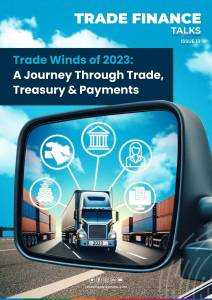Digital trade finance platform Contour has announced its closure, citing insufficient funding from its bank shareholders.
Operations will cease on November 30, leaving users a brief window to complete transactions and download essential data. This development was first reported by Global Trade Review (GTR).
Contour was launched in 2020 by a group of leading banks, including ANZ, BNP Paribas, HSBC, and Standard Chartered, with the aim of digitising and streamlining the documentary trade process.
The platform allowed banks and corporates to issue, manage, and process letters of credit (LCs) electronically.
At its peak, Contour boasted a network of 21 banks and a range of partners across various sectors. Contour also had a number of integration and documentation partners, including Finastra, CargoX, Bolero and Surecomp.
However, despite its advantages, Contour was unable to attract enough users to its platform. As a result, it was unable to generate enough revenue to cover its costs.
Contour joins a growing list of platforms that have failed to sustain themselves, including Marco Polo, we.trade and Tradelens. These platforms, despite their initial promise, have struggled to achieve the scale and interoperability needed for long-term viability.
History of Contour
Contour’s journey began in April 2018 with global banks testing next-generation technology for trade finance on R3’s Corda platform.
The platform had several milestones.
By February 2019, a global trial explored the benefits of enterprise distributed ledger technology (DLT) for Documentary Trade.
The commercial launch of Contour’s Beta network occurred in January 2020, followed by its official launch into live production in October of the same year.
The platform collaborated with Finastra to offer a new digital trade finance network, aiming to bring together banks and corporates globally. Other significant partnerships were with Tata Power, IBM TradeLens (prior to its collapse), and the Shenzhen FinTech Institute of the People’s Bank of China.
The platform also partnered with the Global Legal Entity Identifier Foundation (GLEIF) to enable Legal Entity Identifier (LEI) usage, aiming to create a more transparent trading environment.
In addition to its various partnerships and milestones, Contour had embarked on a next phase focused on tokenising digital trade assets (listen to our podcast, with Contour).
The concept was to allow corporates to originate an asset and either maintain it on their balance sheet or sell it to a bank. Banks could then package, securitise, and sell multiple transactions to investors in the secondary market.
The first round of digital assets to be minted on Contour would likely have been unfunded bank risk or LC confirmations.
This ambitious phase aimed to bring decentralised finance (DeFi) technology to trade finance, connecting borrowers to new groups of lenders and potentially narrowing the trade finance gap.
However, despite this forward-thinking approach, Contour could not sustain its operations, adding another layer of complexity to its story of innovation and struggle.
The platform’s journey shows a consistent effort to innovate and collaborate. However, it also highlights the challenges of achieving scale and interoperability in a fragmented industry. Contour’s closure adds another chapter to the ongoing narrative of digital trade finance platforms struggling to find a sustainable path.
Trough of disillusionment
The TFG/WTO periodic table of DLT projects, published in November 2020, once served as a comprehensive framework for evaluating the state of digital trade finance platforms.
It categorised various initiatives based on their focus, partnerships, and technological underpinnings.
Contour, like many other platforms, found a place on this table but could not sustain its position, eventually leading to its closure.
This trajectory is well illustrated by the Gartner Hype Cycle, a model that describes the adoption and social application of specific technologies.
According to this model, technologies often experience inflated expectations followed by a ‘trough of disillusionment,’ where they either fail or adapt to market realities.
Contour appears to have entered this trough, unable to emerge on the other side towards a sustainable operational model.

Andre Casterman, Founder, Casterman Advisory, told TFG, “The documentary trade finance market is probably the hardest segment to transform digitally, which is why those courageous ones who dare to innovate in this segment ought to focus on addressing specific pain points and show much patience.
Over the last 5 years, we have witnessed many banks adopting document checking and compliance monitoring technologies. Also, large corporates are increasingly adopting multi-banking trade platforms as they have done on the treasury side for around two decades.
I expect much progress in the near term on this front thanks to several platforms, including Contour, offering relevant multi-banking options for MNCs. But patience is key, have banks involved in consortia lost patience with themselves?”
Interoperability was a central theme in Contour’s strategy, as revealed in a fireside chat. The platform aimed to serve as a bridge between various stakeholders in the trade finance ecosystem, from banks to corporates to digital documentation partners.
While this focus on interoperability was one of its unique selling points, it also became a complex challenge. The platform discovered that achieving true interoperability, where systems can easily exchange and make use of information, is far from straightforward.
Despite its efforts to bridge gaps in the trade ecosystem, Contour found that interoperability alone could not solve the industry’s deeply rooted issues.
Wider context: 3 potential reasons why platforms are failing
There are several factors that could have contributed to Contour’s failure, and these can be understood better in the context of broader industry trends and challenges.
- Timing and market readiness
- One possibility is that Contour was simply too early for the market. The trade finance industry has been slow to adopt new technologies, and Contour’s ambitious agenda may have been ahead of its time, as also outlined by Dani Cotti, speaking to TFG in February 2023. Trade digitalisation is proving to be an evolutionary process rather than a revolutionary one.
- Complexity and interoperability
- Contour faced the inherent challenges of digitising a complex and global industry. Creating a single platform that meets the needs of all stakeholders is a monumental task. This was highlighted in a fireside chat where Contour discussed the misconceptions of interoperability. While the platform aimed to bridge gaps in the trade ecosystem, it found that interoperability is not the panacea it’s often made out to be.
- Business model and sustainability
- Contour’s business model relied on transaction fees to generate revenue. However, it may have been challenging to charge fees high enough to cover operational costs. Even with a concrete strategy, product, and value proposition, achieving profitability can be elusive.
Dani Cotti, founding partner, T3i and CEO at Cotti Trade & Treasury said, “Well there is a main common denominator in all the trade failures over the past 2 years – blockchain and DLT. There are other common denominators that have played different roles in each of these demises, as outlined in this article 6 lessons from the trade tech industry.
Bank consortiums have proven to be a dead-end as so far, they’ve failed to balance the different interests. The value propositions were too narrow and not compelling enough for corporates to change their current processes, systems, and set-ups. These current methods may not be ideal, but they manage the movement of goods and funds from one location to another, and they may not want to change this.”
What does Contour’s collapse mean for digital trade finance?
Contour’s collapse is a setback for the digital trade finance industry, but it does not necessarily mean that the industry is doomed. There are a number of other digital trade platforms in operation, including essDOCS, eTradeConnect, and Trade Finance Distribution Initiative (TFDI).
These platforms are all at different stages of development, but they are all making progress in digitising and streamlining the trade finance process.
David Meynell, owner of TradeLC Advisory and Digital Rules Advisor to C4DTI told TFG, “Whilst it is frustrating to see another digital trade initiative disappear, there is still significant cause for optimism. The recent UK Electronic Trade Documents Act will facilitate and support further ambitions whilst promoting an open environment.”
However, Contour’s collapse does raise some important questions about the future of digital trade finance.
Is there is enough room in the market for multiple platforms? It is also worth considering whether digital trade platforms can be successful without the backing of major banks.
Evolution, not a revolution
Contour’s collapse is a reminder that the digital trade finance industry is still in its early stages of development. However, the potential benefits of digital trade finance are significant, and there is a strong commitment to making digital trade finance a success.
By addressing the challenges that the industry faces, and by focusing on building a more inclusive digital trade finance ecosystem, we can help to ensure that digital trade finance reaches its full potential and benefits all stakeholders, including SMEs.
In order to address the challenges facing the digital trade finance industry, it is important to focus on:
- Improving the adoption of new technologies: The trade finance industry needs to become more open to adopting new technologies. This can be done by educating banks and corporates about the benefits of digital trade finance, and by providing financial incentives to adopt digital trade finance platforms.
- Making digital trade finance more inclusive: Digital trade finance platforms need to be designed to be accessible to all stakeholders, including SMEs. This can be done by developing open source digital trade finance platforms, and by providing government-backed initiatives to promote the adoption of digital trade finance by SMEs.
- Improving the interoperability of digital trade finance platforms: Digital trade finance platforms need to be interoperable with each other. This would make it easier for banks and corporates to use multiple platforms, and it would also create a more seamless experience for users.
- Addressing concerns about data security and privacy: Digital trade finance platforms need to implement robust security and privacy measures. This would help to build trust with banks and corporates, and it would make them more likely to adopt digital trade finance solutions.
Casterman said: “As an industry, we now need to focus on leveraging the Electronic Trade Documents Act (ETDA) to contribute to closing the trade finance gap and involve those who can move the needle faster than banks, i.e., alternative lenders and institutional investors.
They will contribute to supporting the real economy and find an attractive return on investment.”
The closure of Contour serves as a cautionary tale for the trade finance industry. While technological innovation offers the promise of revolutionising the sector, the fundamental issues of a viable business model and secure funding mechanisms remain.
As the industry moves forward in a landscape reshaped by the ETDA, the lessons gleaned from the failure of platforms like Contour will be invaluable.
The industry finds itself at a crossroads, and the path it chooses will have long-lasting implications for the future of digital trade finance.












































